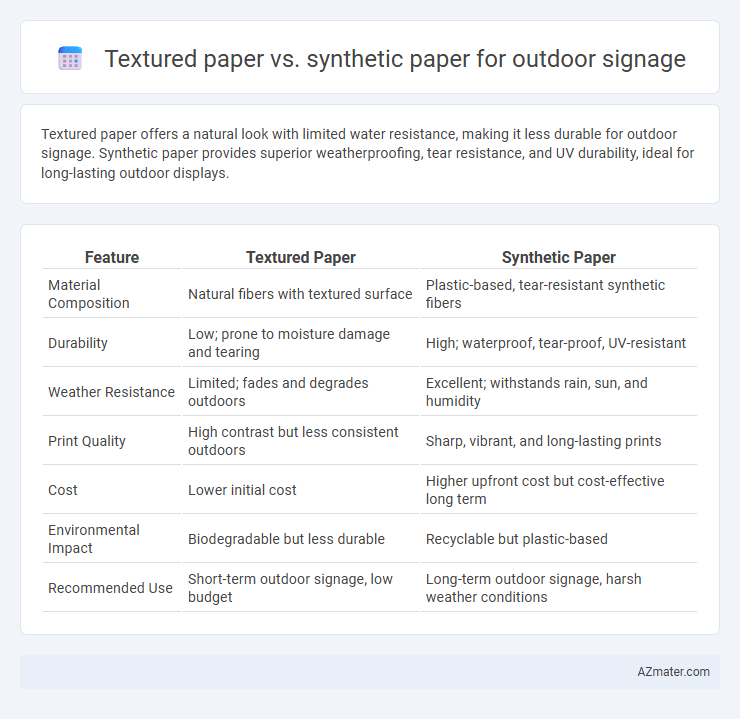Textured paper offers a natural look with limited water resistance, making it less durable for outdoor signage. Synthetic paper provides superior weatherproofing, tear resistance, and UV durability, ideal for long-lasting outdoor displays.
Table of Comparison
| Feature | Textured Paper | Synthetic Paper |
|---|---|---|
| Material Composition | Natural fibers with textured surface | Plastic-based, tear-resistant synthetic fibers |
| Durability | Low; prone to moisture damage and tearing | High; waterproof, tear-proof, UV-resistant |
| Weather Resistance | Limited; fades and degrades outdoors | Excellent; withstands rain, sun, and humidity |
| Print Quality | High contrast but less consistent outdoors | Sharp, vibrant, and long-lasting prints |
| Cost | Lower initial cost | Higher upfront cost but cost-effective long term |
| Environmental Impact | Biodegradable but less durable | Recyclable but plastic-based |
| Recommended Use | Short-term outdoor signage, low budget | Long-term outdoor signage, harsh weather conditions |
Introduction to Outdoor Signage Materials
Outdoor signage materials must balance durability, visibility, and weather resistance to ensure long-lasting performance. Textured paper offers a natural, tactile finish ideal for short-term, eco-friendly applications but lacks water resistance and durability under harsh outdoor conditions. Synthetic paper provides superior weatherproof qualities, including waterproofing and tear resistance, making it the preferred choice for long-term outdoor signage exposed to rain, sun, and wind.
What Is Textured Paper?
Textured paper, characterized by its embossed surface patterns such as linen or felt finishes, offers a tactile quality that enhances visual appeal in outdoor signage. Its natural fiber composition provides breathability yet may absorb moisture, making it less durable compared to synthetic paper under harsh weather conditions. Synthetic paper, made from plastic resins like polypropylene, delivers superior water resistance and longevity, ideal for outdoor signage requiring exposure to rain, UV rays, and abrasion.
What Is Synthetic Paper?
Synthetic paper is a durable, waterproof material made from plastic resins such as polypropylene or polyethylene, designed to withstand harsh outdoor conditions without tearing or fading. Unlike textured paper, synthetic paper offers superior resistance to moisture, UV exposure, and chemicals, making it ideal for outdoor signage that requires long-lasting visibility and strength. Its smooth surface also ensures high-quality print output with vibrant colors and sharp details, enhancing the effectiveness of outdoor advertisements.
Weather Resistance: Textured vs Synthetic Paper
Synthetic paper offers superior weather resistance compared to textured paper, making it ideal for outdoor signage exposed to rain, humidity, and UV rays. Unlike textured paper, which can absorb moisture and degrade quickly, synthetic paper is waterproof, tear-resistant, and maintains color vibrancy under harsh environmental conditions. This durability ensures longer-lasting signage with minimal maintenance in outdoor settings.
Durability and Longevity Comparison
Textured paper offers a natural feel but lacks the durability needed for prolonged outdoor signage exposure, often succumbing to moisture, UV rays, and tearing within weeks. Synthetic paper, composed of durable plastic resins, provides superior resistance to weather elements, maintaining print quality and structural integrity for years in harsh outdoor conditions. For longevity and durability in outdoor signage, synthetic paper significantly outperforms textured paper, making it the preferred choice for long-term applications.
Print Quality and Visual Impact
Textured paper offers a natural, tactile surface that enhances print quality with rich color depth and subtle contrast, ideal for premium outdoor signage requiring a sophisticated visual impact. Synthetic paper excels in durability and weather resistance, maintaining vibrant colors and sharp details under harsh outdoor conditions, ensuring long-lasting signage clarity. Comparing the two, synthetic paper provides superior resilience and consistent print quality over time, while textured paper delivers a distinctive aesthetic that elevates brand perception in less extreme environments.
Cost Analysis of Textured and Synthetic Paper
Textured paper typically offers a lower initial cost compared to synthetic paper, making it a budget-friendly option for short-term outdoor signage projects. However, synthetic paper, despite its higher upfront price, provides superior durability, water resistance, and longer lifespan, reducing the frequency and cost of replacements over time. When evaluating cost-efficiency for outdoor signage, factoring in maintenance and durability, synthetic paper often yields better long-term value despite higher initial expenses.
Environmental Considerations
Textured paper offers a biodegradable option for outdoor signage, breaking down naturally and reducing landfill impact, but it may degrade faster under harsh weather conditions. Synthetic paper provides superior durability and water resistance, which extends the lifespan of outdoor signs, but its production involves non-biodegradable materials and can contribute to microplastic pollution. Choosing between textured and synthetic paper requires balancing environmental impact with performance needs, favoring recycled or eco-certified synthetic options to minimize ecological footprint.
Installation and Maintenance Factors
Textured paper for outdoor signage offers easy installation with adhesive backing but tends to degrade faster under harsh weather, requiring frequent replacement and higher maintenance. Synthetic paper provides superior durability and water resistance, ensuring long-lasting signage that withstands rain, UV exposure, and physical abrasion without peeling or fading. Maintenance for synthetic paper is minimal, as it resists tearing and can be cleaned easily, reducing overall lifecycle costs despite higher initial installation effort.
Choosing the Best Option for Outdoor Signage
Textured paper offers a natural feel and good print quality but lacks durability and water resistance, making it less suitable for harsh outdoor conditions. Synthetic paper, made from durable materials like polypropylene, provides superior moisture resistance, tear strength, and UV protection, ensuring longevity and vibrant graphics in outdoor signage. Choosing synthetic paper is optimal for outdoor signage that requires resilience against weather elements and extended display life.

Infographic: Textured paper vs Synthetic paper for Outdoor signage
 azmater.com
azmater.com